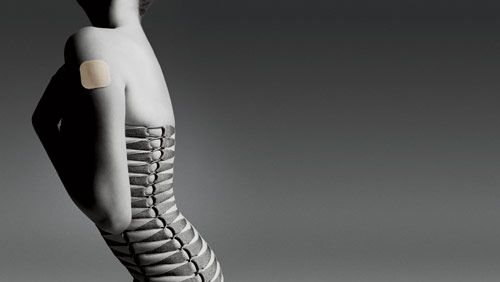Which Birth Control Is Right for You?
Quit playing reproductive roulette and own your sex life with MC's very own guide to birth control. To compare a list of pills and their effects, check out our Contraceptive Cheat Sheet.

As if outsmarting biology weren't tricky enough, the recession is the latest force of nature to hamper our reproductive health. In one survey released last fall, almost a quarter of women polled said paying for contraception was a struggle since the economy imploded. Scarier still, a full 18 percent copped to skimping on the Pill — skipping days, putting off prescriptions, or even going cold turkey — all to save a little cash.
Luckily, there's good news. President Obama has pledged $648 million to a global family-planning campaign, plus another $114 million to fight teen pregnancy in the U.S. The FDA recently approved a new single-dose version of Plan B, the morning-after pill, out this month (no prescription required for women 17 or older). And the number of women buying condoms is inching up, showing we're ready for action — but on our terms.
On the flip side, what if you are ready for baby-making but freaked by the thought of infertility? We got the scoop on the newest reproductive technologies out there from the doctor who performed the first-ever successful ovary transplant. So whether or not you've got babies on the brain, we've got your back.
So, which birth control is right for you?
Barrier
TRIED AND TRUE: Condom. The female condom never quite found its, um, niche in the U.S. But condom companies now target women with everything from vibrating rings to increasingly lubed-up (male) rubbers. Trojan, whose latest "Ecstasy" line targets women with commercials featuring shag-happy gals, says women now buy 38 percent of condoms, up from 30 percent in 2001. Best of all, they're cheap — about $1 each, and cost less when bought in bulk.
RUNNERS-UP: Diaphragm, sponge, spermicide. Less than 0.2 percent of women use a diaphragm, and the sponge and spermicide are unpopular, too, according to the CDC. Another downer: Some guys report "bumping" into a diaphragm during sex.
Hormonal
TRIED AND TRUE: The Pill. Birth control pills are the most popular contraceptive among American women. And aside from being convenient, the new breed of pills, when prescribed off-label, helps with everything from acne to PMS. The vaginal ring, a newer hormonal contraceptive, works like the Pill and also has off-label benefits.
Stay In The Know
Get exclusive access to fashion and beauty trends, hot-off-the-press celebrity news, and more.
RUNNERS-UP: Shot, patch, IUD. Just 3.3 percent of women use Depo-Provera, a four-times-a-year shot that stops ovulation. A January 2010 study links the shot to bone loss, and smokers are at elevated risk, so ask your doctor about this option before getting it. While only 1.3 percent of women use IUDs, Mirena, an IUD from Bayer, was recently approved by the FDA to combat heavy menstrual bleeding. (A nonhormonal IUD, made of copper, also exists.)
-
 Netflix's 'North of North' Transports Viewers to the Arctic Circle—Meet the Cast of Inuit Indigenous Actors
Netflix's 'North of North' Transports Viewers to the Arctic Circle—Meet the Cast of Inuit Indigenous ActorsThe new comedy follows a modern Inuk woman determined to transform her life.
By Quinci LeGardye
-
 Princess Beatrice's Husband Pays a Rare Tribute to These Royal Family Members on Instagram
Princess Beatrice's Husband Pays a Rare Tribute to These Royal Family Members on InstagramEdoardo Mapelli Mozzi shared some behind-the-scenes snaps from the F1 Grand Prix in Bahrain.
By Kristin Contino
-
 Allow Kathy Bates to Convince You to Grow Out Your Grays
Allow Kathy Bates to Convince You to Grow Out Your GraysOne look at her new style and you'll be canceling your root touch-up pronto.
By Ariel Baker
-
 Senator Klobuchar: "Early Detection Saves Lives. It Saved Mine"
Senator Klobuchar: "Early Detection Saves Lives. It Saved Mine"Senator and breast cancer survivor Amy Klobuchar is encouraging women not to put off preventative care any longer.
By Senator Amy Klobuchar
-
 I'm an Egg Donor. Why Was It So Difficult for Me to Tell People That?
I'm an Egg Donor. Why Was It So Difficult for Me to Tell People That?Much like abortion, surrogacy, and IVF, becoming an egg donor was a reproductive choice that felt unfit for society’s standards of womanhood.
By Lauryn Chamberlain
-
 The 20 Best Probiotics to Keep Your Gut in Check
The 20 Best Probiotics to Keep Your Gut in CheckGut health = wealth.
By Julia Marzovilla
-
 Simone Biles Is Out of the Team Final at the Tokyo Olympics
Simone Biles Is Out of the Team Final at the Tokyo OlympicsShe withdrew from the event due to a medical issue, according to USA Gymnastics.
By Rachel Epstein
-
 The Truth About Thigh Gaps
The Truth About Thigh GapsWe're going to need you to stop right there.
By Kenny Thapoung
-
 The High Price of Living With Chronic Pain
The High Price of Living With Chronic PainThree women open up about how their conditions impact their bodies—and their wallets.
By Alice Oglethorpe
-
 I Used to Imagine Murdering the Men I Dated
I Used to Imagine Murdering the Men I DatedFalling in love helped me finally figure out why.
By Jessica Amento
-
 60 Workout Apps for Women Who Want Results (Without a Gym Membership)
60 Workout Apps for Women Who Want Results (Without a Gym Membership)Buying Guide Easy fitness plans you can follow without fear of judgment.
By Bianca Rodriguez